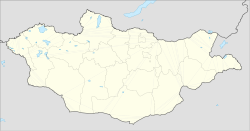- Oyu Tolgoi mine
-
Oyu Tolgoi
Number 1 Shaft at Oyu TolgoiLocation Location in Mongolia 43°00′30″N 106°50′35″E / 43.00833°N 106.84306°ECoordinates: 43°00′30″N 106°50′35″E / 43.00833°N 106.84306°E
Location Oyu Tolgoi Amaig Ömnögovi Country Mongolia Owner Company Ivanhoe Mines Mongolia Inc Website www.ivanhoemines.com The Oyu Tolgoi mine (Mongolian: Оюу Толгой, also Oyuu Tolgoi, Turquoise Hill) is a combined open pit and underground mining project in Khanbogd sum within the south Gobi Desert, approximately 235 kilometres (146 mi) east of the Ömnögovi Province capital Dalanzadgad. The site was discovered in 2001 and is being developed as a joint venture between Ivanhoe Mines, Rio Tinto and the Government of Mongolia. The mine is under construction as of 2010 and scheduled to begin production in 2013.
The Oyu Tolgoi mining project is the largest financial undertaking in Mongolia's history and is expected upon completion to account for more than 30% of the country's gross domestic product. Copper production is expected to reach 450,000 tonnes (500,000 short tons) annually. Financing for the project has come in part from the Rio Tinto Group and an investment agreement between Ivanhoe Mines and the government of Mongolia.
Contents
History
Canadian-based Ivanhoe Mines discovered the gold-copper ore deposit in 2001 in the Gobi Desert of Mongolia. It is in an area known as Oyu Tolgoi (Mongolian for Turquoise Hill),[1] where in the time of Genghis Khan outcropping rocks were smelted for copper.[2] By 2003 there were 18 exploration drill rigs on the property employing approximately 200 people, and Oyu Tolgoi was the "biggest mining exploration project in the world."[1]
Description
The Oyu Tolgoi mine is in the South Gobi Desert of Mongolia, 80 kilometres (50 mi) north of Mongolia's border with the People's Republic of China, where the mined copper is expected to be shipped.[2] The Oyu Tolgoi deposits contain (as of 2010) 79 billion pounds (35,833,000 tonnes) of copper, and 45 million ounces (1,275,000,000 grams) of gold.|[3] Production is scheduled to begin in 2013 and to reach full capacity in 2018. Over the anticipated life of mine (45 years), Oyu Tolgoi is scheduled to produce 450,000 tonnes (500,000 short tons) of copper per year, an amount equal to 3% of global production. Oyu Tolgoi is also expected to produce 330,000 ounces of gold annually.[4][5]
Mining and milling
Oyu Tolgoi will use both underground and open pit mining techniques. Initially the mine will produce 70,000 tonnes per day, ramping up to 85,000 tonnes per day with ore from both the open pit and the underground mine (underground mining is to be done by block caving). The yield from the first phase of mining will be ground through one semi-autogenous grinding mill (SAG mill). Expansion to new underground areas will result in an additional ramp up to 140,000 tonnes per day, with possible expansion to 170,000 tonnes per day.[6]
Financing
As of 2010, the estimated costs for bringing the Oyu Tolgoi mine into production was US$4.6 billion,[7] making it (financially) the largest project in Mongolian history.[8] The mine will account for more than 30% of the Mongolian GDP.[6] In early 2010 global mining company Rio Tinto owned 22.4% of Oyu Tolgoi owner Ivanhoe Mines, and gave both technical assistance and financial support to the project. At the time Rio Tinto had the option of increasing their stake to 46.6%. On 31 March 2010 the Government of Mongolia approved an investment agreement where they would purchase 34% of the project.[9] In October 2010, Ivanhoe announced a new US$1 billion share offering in order to raise funds to develop this mine.[10] Rio Tinto increased its ownership of Ivanhoe in December 2010, also assuming direct management of the design and construction of the project, however without fulfilling another aim, to achieve direct ownership of the mine.[11][12]
References
- ^ a b Grainger, David (22 December 2003). "The Great Mongolian Gold Rush The land of Genghis Khan has the biggest mining find in a very long time. A visit to the core of a frenzy in the middle of nowhere.". CNN Money (Fortune Magazine). http://money.cnn.com/magazines/fortune/fortune_archive/2003/12/22/356094/index.htm. Retrieved 19 January 2010.
- ^ a b Brooke, James (15 October 2004). "Mining brings the Gobi Desert to life". The New York Times. http://www.nytimes.com/2004/10/14/business/worldbusiness/14iht-tugrik.html. Retrieved 19 January 2010.
- ^ Hill, Leizel (6 January 2010). "Ivanhoe Mines hires Citi to advise, mulls 'range' of deals". Creamer Mining Weekly. http://www.miningweekly.com/article/ivanhoe-miners-hires-citi-to-advise-on-strategic-options-2010-01-06. Retrieved 19 January 2010.
- ^ MacDonald, Alex (1 April 2010). "Rio Tinto moves to development phase for $US4bn Oyu Tolgoi mine". The Wall Street Journal. http://www.theaustralian.com.au/business/mining-energy/rio-tinto-moves-to-development-phase-for-us4bn-oyu-tolgoi-mine/story-e6frg9dx-1225848299480. Retrieved 2 April 2010.
- ^ "Oyu Tolgoi 2010 Spending Budgeted at $758 Million". Engineering Mining Journal. http://e-mj.com/index.php/news/asia/144-oyu-tolgoi-2010-spending-budgeted-at-758-million.html. Retrieved 2 April 2010.
- ^ a b "Oyu Tolgoi Gold and Copper Project, Mongolia". Mining-Technology. http://www.mining-technology.com/projects/oyu-tolgio/. Retrieved 21 April 2010.
- ^ Morrison, Rod (17 June 2010). "PFI - Oyu Tolgoi mine picks two". Reuters. http://www.reuters.com/article/idUSLDE65G0EV20100617. Retrieved 22 June 2010.
- ^ March, Stephanie (15 January 2010). "Concern over giant Mongolian min". Australian Broadcasting Corporation - Radio Australia. http://www.radioaustralia.net.au/connectasia/stories/201001/s2793142.htm. Retrieved 18 January 2010.
- ^ Rocha, Euan (31 March 2010). "UPDATE 2-Ivanhoe finalizes Oyu Tolgoi investment agreement". Reuters. http://www.reuters.com/article/idUSN3120661520100331?type=marketsNews. Retrieved 1 April 2010.
- ^ "CTV News". http://www.ctv.ca/generic/generated/static/business/article1761742.html. Retrieved 2010-10-18.
- ^ Tio's peace pact tames Canadian copper monster The Australian, published: 10 December 2010, accessed: 10 December 2010
- ^ "Ivanhoe Mines 2010 Annual Information Form page 16/95". March 2011. http://www.ivanhoe-mines.com/i/pdf/2010_AIF.PDF.
External links
Categories:- Gold mines in Mongolia
- Underground mines in Mongolia
- Surface mines in Mongolia
- Copper mines in Mongolia
Wikimedia Foundation. 2010.



